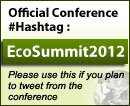« Go back to e-newsletter overview
EcoSummit 2012 E-Newsletter: June 2012
A Field Trip to Stone Lab
The Great Lakes watershed is home to some 40 million Canadians and Americans who depend on the 200,000 square miles of the Great Lakes for food, recreation and transportation. The region’s shorelines are dotted with thriving urban areas and rich, productive farmland that have strained nature’s ability to sustain itself.
For much of the 19th and 20th centuries, the Great Lakes suffered from the industrial pollution dumped into the waterways from steel mills, auto factories and many other sources of industrial pollution. In 1969, the problem grew so severe that the Cuyahoga River caught on fire in Cleveland, just a short distance from where the river empties into Lake Erie.
Throughout the many challenges and successes of the Great Lakes has stood The Ohio State University’s Stone Laboratory. Built in 1895 on Gibraltar Island in Lake Erie, Stone Lab is the oldest freshwater biological field station in the nation and will be a field trip destination during EcoSummit 2012.
“I want people who visit Stone Lab on the field trip to walk away with an improved knowledge of Lake Erie,” said Dr. Jeffrey Reutter, the director of the Ohio Sea Grant College Program at Stone Laboratory.
“Lake Erie is the best example of how to mistreat a water resource and the best model of how to manage an ecosystem,” according to Reutter. “It’s gone from the problems of industrial pollution and agricultural runoff to being one of the great sources for walleye.”
Reutter has worked at Stone Lab since 1971 and has witnessed many of the lake’s challenges. In his 41 years on the lake, he’s learned that the work of eco-restoration is never completed. “Back in 1985, we made the mistake of thinking we had reached our goal. So we stopped monitoring the lake. It taught me that you could never let your guard down when it comes to protecting ecosystems.”
He points to the Maumee River, which enters Lake Erie in its western basin near Toledo, as an example of nature that will always be a work in progress. The river is one of the most important spawning grounds for walleye on Lake Erie, but it’s also one of the leading sources of phosphorous from farms that drain into the watershed.
Reutter says EcoSummit attendees who visit Stone Lab will be given the opportunity to learn first hand about the progress on Lake Erie when they go for a two-hour fishing trip. “I believe the best learning comes from firsthand experience.”
But Reutter admits he will draw the line for one of Stone Lab’s most successful ecosystem restoration projects, the revival of the Lake Erie water snake. In the late 1990s, the federal government designated it a threatened species after the snake population dropped to just 2,000 snakes. Thanks to research at Stone Lab and an effective public education program, water snakes have rebounded.
“We’ll give the EcoSummit visitors firsthand experience with the fish, but not the snakes,” said Reutter.
See other articles in the June 2012 newsletter:
- Letter from the EcoSummit 2012 Host Committee Chair
- Welcome to Columbus: Building a Sustainable Neighborhood
- Where Science and Policy Meet
- E.O. Wilson Draws the Connections Between Mankind and Forest Floor





